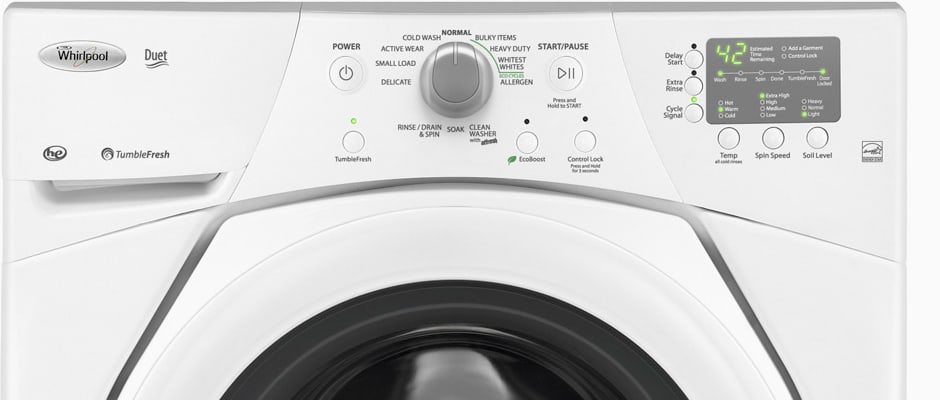Introduction
Design & Usability
{{section_header}}{{section.name}}{{/section_header}}
On the sales floor, the {{product.name}} is virtually indistinguishable from any other machine in its price range.
This model's simple controls are easy to decipher, see, and use. Unlike some washers we test, its cycle selector knob remains on whichever wash you last used—helpful if you use the same cycle over and over again. The surrounding control panel is a bit crowded, but all the options and buttons are well-labeled and easy to push. The door, however, felt less well designed. It is encased in a rather cheap-feeling plastic. Still, the hinges and locking mechanism worked well.
{{photo_gallery "Front Image", "Controls 1 Photo", "Controls 2 Photo", "Drawer Photo", "Lint Trap Photo", "Interior Photo", "Interior Detail Photo", "Sides Photo", "Sides Detail 1 Photo", "Side Detail 2 Photo", "Back Photo", "Back Detail Photo"}}
Performance & Features
{{section_header}}{{section.name}}{{/section_header}}
Solid cleaning performance on most cycles, but some were clearly better than others
The Duet did an excellent job on the often-used Normal cycle. In five minutes shy of an hour, the Whirlpool got most stains very close to white. It did its best work on blood, cocoa and wine stains, though it also did a decent job getting out carbon and oil. Dialing up the heat, the Whitest Whites cycle showed us that tricky oil-based stains were diminished in appearance, and red wine stains all but disappeared. If you spill something on your favorite shirt and you've got a {{product.name}} in your laundry room, choose this cycle. On the other hand, the Heavy Duty cycle also didn't live up to the expectations its name or its claim of a 72-minute cycle time, barely outperforming the much shorter Normal wash.
For features, this Duet offers EcoBoost, an option that slightly reduces water temperature to save money and energy. There’s also TumbleFresh, which turns clothes over to keep them from getting musty from sitting in the washer after a cycle. The rest of the offerings are run-of-the-mill.
When it comes to water and energy, the Whirlpool Duet WFW9151YW is inefficient compared to other front loading machines we’ve tested, with an annual ownership cost close to $38 on average. If you’re replacing an older washer or a top loader, though, you’ll still notice a dip in your water and electric bills.
Conclusion
{{section_header}}{{section.name}}{{/section_header}}
This Duet inspires boring adjectives.
Although it suffers from uneven performance across cycles and lacks some options that can be found on pricier machines, this Duet does a good job on the frequently-used Normal cycle. Otherwise, every cycle had a sticking point that kept us from recommending it without reservation. The Delicates cycle, for instance, wasn’t that gentle on clothes. The Heavy Duty cycle took longer than the Normal cycle for only slightly better results.
Rather than settling for this washer, we recommend shopping around; this is a crowded segment with stiff competition. You could almost certainly find a better washer with more features (like a Sanitize cycle) for a better price.
Science Introduction
{{section_header}}{{section.name}}{{/section_header}}
The {{product.name}} had a good Normal cycle performance. However, every other cycle seemed to lag behind. The Heavy Duty cycle took over an hour and offered little improvement in stain removal. The Delicates cycle was too heavy handed with our test loads and too gentle with the stains. Overall, this machine offered a middle of the road performance with a very mundane repertoire of features.
The Normal Cycle
{{section_header}}{{section.name}}{{/section_header}}
We have reiterated a few times that the Normal cycle was superior to the others. We came to that conclusion using stain strips. These strips are coated with various household substances like red wine and sebum (sweat). We place these stain strips in the washer during each test cycle. When the cycle is complete, we take the strips out and scan them to analyze how much of the stain is removed. Our numbers show that the Normal cycle did the best, especially with blood, wine and cocoa. That's a good swath considering that those stains are all over the pH scale.
{{photo_gallery "Science Section 1 Images"}}
The Gentle Cycle
{{section_header}}{{section.name}}{{/section_header}}
Clothes handling should be considered when factoring the cost of the machine. In order to determine how destructive a wash cycle is on clothes, we use mechanical action strips. These are strips of cloth with five one-inch holes in them. When a cycle is done, these strips are dried out and all the loose threads within the holes are counted. Definitely, the least fun part of our jobs, but someone has to do it.
Through this process, we found that the {{product.name}}'s Delicates cycle is about as destructive as the Normal cycle. Talk about an engineering oversight...
{{photo_gallery "Science Section 2 Images"}}
Cost
{{section_header}}{{section.name}}{{/section_header}}
When we set up the {{product.name}}, we also hooked up water and watt meters. We kept a record of how much water and electricity was consumed for each cycle. The most miserly Cold Wash uses only seven gallons, while the Allergen cycle uses more than 23. Most other cycles fall between 11 and 15 gallons. This translated to reasonable, ranging from less than four cents to 17 cents. Most cycles cost around a dime to run, and none of them are particularly expensive.
Overall, if your costs are aligned with national averages, the {{product.name}} will cost about $38.09 a year to run.
{{photo_gallery "Science Section 3 Images"}}
Meet the tester
Keith was the Editor in Chief of Reviewed's appliance and automotive sites. His work has appeared in publications such as Wired, Car & Driver, and CityLab.
Checking our work.
Our team is here to help you buy the best stuff and love what you own. Our writers, editors, and experts obsess over the products we cover to make sure you're confident and satisfied. Have a different opinion about something we recommend? Email us and we'll compare notes.
Shoot us an email

